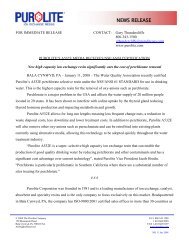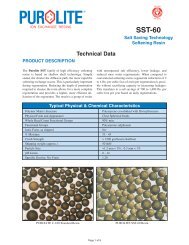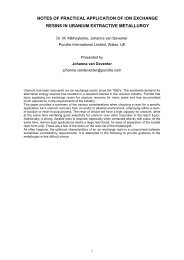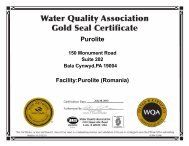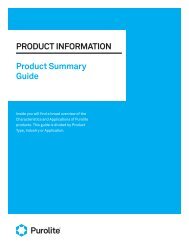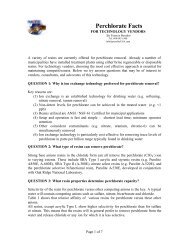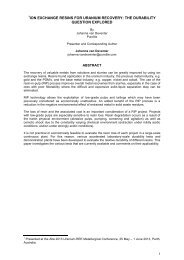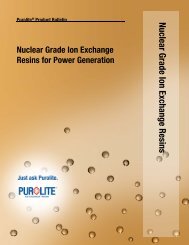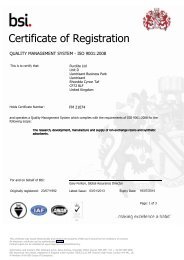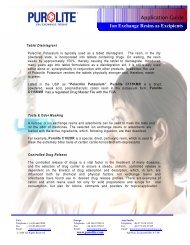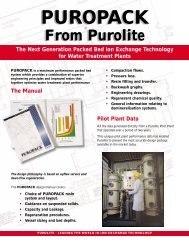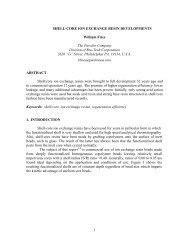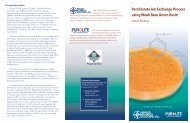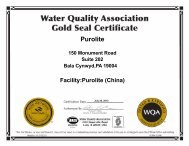Purolite Water Softening Resin Guide By: Chubb Michaud Water ...
Purolite Water Softening Resin Guide By: Chubb Michaud Water ...
Purolite Water Softening Resin Guide By: Chubb Michaud Water ...
You also want an ePaper? Increase the reach of your titles
YUMPU automatically turns print PDFs into web optimized ePapers that Google loves.
notes determine this. Once the salt dose (for the quality needed) is determined, the capacity isset and the system design can be initiated.Capacity ResponseCAPACITY (kilograins/cu ft)302010theoretical = 6000 grains/lb salttypical = 3350 grains/lb saltreduced brine dose = ~4000 grains/lb saltand saves 87 lbs of salt per year00 1 2 3 4 5 6 7 8 9 10 11 12 13 14 15REGENERANT LEVEL (lb/cu ft)Although synthetic resins are very durable, they are subject to degradation due to oxidation andover time. Chlorine and any other oxidants are detrimental. Levels of 0.5 mg/l (0.5 ppm) havelittle affect on resin life but at higher levels the life of the resin can reduce dramatically. Also thepresence of metal ions such as iron (which is common) or copper in the feed water will foul theresin and promote oxidative breakdown and shorten the life further.The basics of ion exchangers have been chemically unchanged for more than 60 years.However, much has been done to improve the efficiency by modifying the bead structure.Normal beads range in particle size from 0.3 to 1.2 mm. This is called “standard Gaussiandistribution. This mix gives good capacity and minimal pressure loss. Most of what has beenwritten about softening pertains to this particle size distribution. The efficiency of softeningresins has been improved by newer manufacturing techniques which are capable of producingbeads that are more uniform in size. Uniform bead products such as <strong>Purolite</strong> PFC100E andPPC100 and PFC100 produce systems with lower pressure drops and better brine efficiencies (upto 10 to 15% over the standard beads). Finer mesh (0.2 to 0.4 mm) beads have also beenintroduced by <strong>Purolite</strong>. These small narrow grade resins are kinetically faster. Using fine meshresin such as <strong>Purolite</strong> C100EFM allows systems that are smaller in size with higher capacity andbetter brine efficiency (a gain of about 10% can be realized).The latest development is the SST bead (Shallow Shell Technology beads manufacturedexclusively by <strong>Purolite</strong> primarily for the USA market) which are not fully functionalized bydepth. This gives the performance of both fine mesh and uniform particle size resins whileproducing higher capacity and lower leakages than any other bead forms at any given salt level.USA Europe Asia PacificTelephone: (1) 610-668-9090 Telephone: +44 1443 229334 Telephone: +86 571 876 31385Fax: (1) 610-668-8139 Fax: +44 1443 227073 Fax: +86 571 876 31385Email: info@puroliteusa.com Email: sales@purolite.com Email: pultalan@purolitechina.com© 2007 All Rights Reserved www.purolite.com App Notes_<strong>Water</strong>Soft_9-20-07



